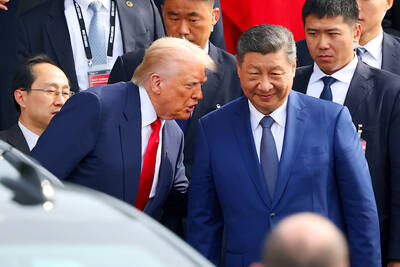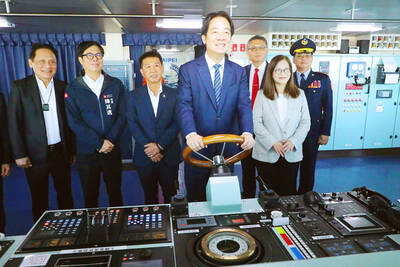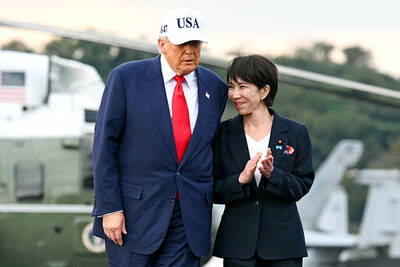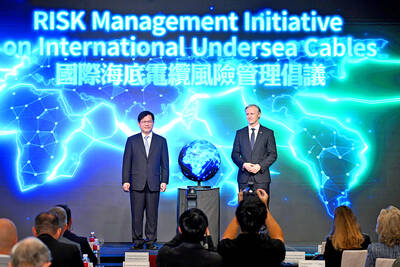A space probe hit its comet target early yesterday in a NASA-directed, Hollywood-style mission that scientists hope will reveal clues to how the solar system formed.
It marked the first time a spacecraft had touched the surface of a comet, and ignited a dazzling fireworks display in space.
The successful strike 134 million kilometers away from Earth occurred just before 6am GMT, according to mission control at NASA's Jet Propulsion Laboratory in Pasadena, which is managing the US$333 million mission.
Scientists at mission control erupted in applause and hugged each other as news of the impact spread.
It was a milestone for the US space agency, which hopes the experiment will answer basic questions about the origins of the solar system.
The cosmic smash-up did not significantly alter the comet's orbit around the sun and NASA said the experiment does not pose any danger to Earth.
An image by the mothership showed a bright spot in the lower section of the comet where the collision occurred that hurled a cloud of debris into space. When the dust settles, scientists hope to peek inside the comet's frozen core -- a composite of ice and rock left over from the early solar system.
"We hit it just exactly where we wanted to," co-investigator Don Yeomans said.
More than 10,000 people packed Hawaii's Waikiki Beach to see the impact on a giant movie screen.
"It's almost like one of those science fiction movies," said Steve Lin, a Honolulu physician as his 7-year old son, Robi, zipped around his beach blanket.
Scientists had compared the suicide journey to standing in the middle of the road and being hit by a truck roaring at 37,000 kph. They expect the crater will be anywhere from the size of a large house to a football stadium and between two and 14 stories deep.
A day earlier, the Deep Impact spacecraft successfully released its barrel-sized "impactor" probe on a high-speed collision course with Tempel 1 -- a pickle-shaped comet half the size of Manhattan.
After its release, the battery-powered probe tumbled in free flight toward the comet and flew on its own without human help during the critical two hours before the crash, firing its thrusters to get the perfect aim of the comet nucleus.
A direct hit was a challenge because NASA's Jet Propulsion Laboratory no longer controlled the probe once it was released from the spacecraft. Even so, the odds favored success based on previous testing.
Along the way, as the comet closed in, the copper probe took close-up pictures of the icy celestial body at a rapid clip until its destruction.

UKRAINE, NVIDIA: The US leader said the subject of Russia’s war had come up ‘very strongly,’ while Jenson Huang was hoping that the conversation was good Chinese President Xi Jinping (習近平) and US President Donald Trump had differing takes following their meeting in Busan, South Korea, yesterday. Xi said that the two sides should complete follow-up work as soon as possible to deliver tangible results that would provide “peace of mind” to China, the US and the rest of the world, while Trump hailed the “great success” of the talks. The two discussed trade, including a deal to reduce tariffs slapped on China for its role in the fentanyl trade, as well as cooperation in ending the war in Ukraine, among other issues, but they did not mention

CALL FOR SUPPORT: President William Lai called on lawmakers across party lines to ensure the livelihood of Taiwanese and that national security is protected President William Lai (賴清德) yesterday called for bipartisan support for Taiwan’s investment in self-defense capabilities at the christening and launch of two coast guard vessels at CSBC Corp, Taiwan’s (台灣國際造船) shipyard in Kaohsiung. The Taipei (台北) is the fourth and final ship of the Chiayi-class offshore patrol vessels, and the Siraya (西拉雅) is the Coast Guard Administration’s (CGA) first-ever ocean patrol vessel, the government said. The Taipei is the fourth and final ship of the Chiayi-class offshore patrol vessels with a displacement of about 4,000 tonnes, Lai said. This ship class was ordered as a result of former president Tsai Ing-wen’s (蔡英文) 2018

Japanese Prime Minister Sanae Takaichi yesterday lavished US President Donald Trump with praise and vows of a “golden age” of ties on his visit to Tokyo, before inking a deal with Washington aimed at securing critical minerals. Takaichi — Japan’s first female prime minister — pulled out all the stops for Trump in her opening test on the international stage and even announced that she would nominate him for a Nobel Peace Prize, the White House said. Trump has become increasingly focused on the Nobel since his return to power in January and claims to have ended several conflicts around the world,

GLOBAL PROJECT: Underseas cables ‘are the nervous system of democratic connectivity,’ which is under stress, Member of the European Parliament Rihards Kols said The government yesterday launched an initiative to promote global cooperation on improved security of undersea cables, following reported disruptions of such cables near Taiwan and around the world. The Management Initiative on International Undersea Cables aims to “bring together stakeholders, align standards, promote best practices and turn shared concerns into beneficial cooperation,” Minister of Foreign Affairs Lin Chia-lung (林佳龍) said at a seminar in Taipei. The project would be known as “RISK,” an acronym for risk mitigation, information sharing, systemic reform and knowledge building, he said at the seminar, titled “Taiwan-Europe Subsea Cable Security Cooperation Forum.” Taiwan sits at a vital junction on